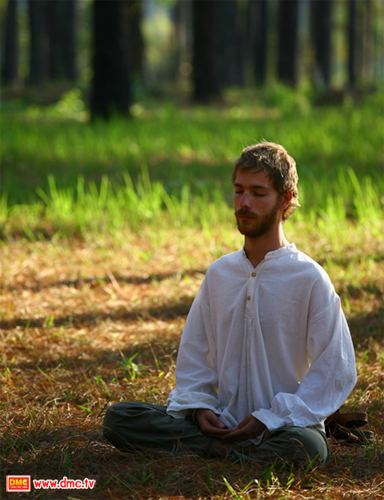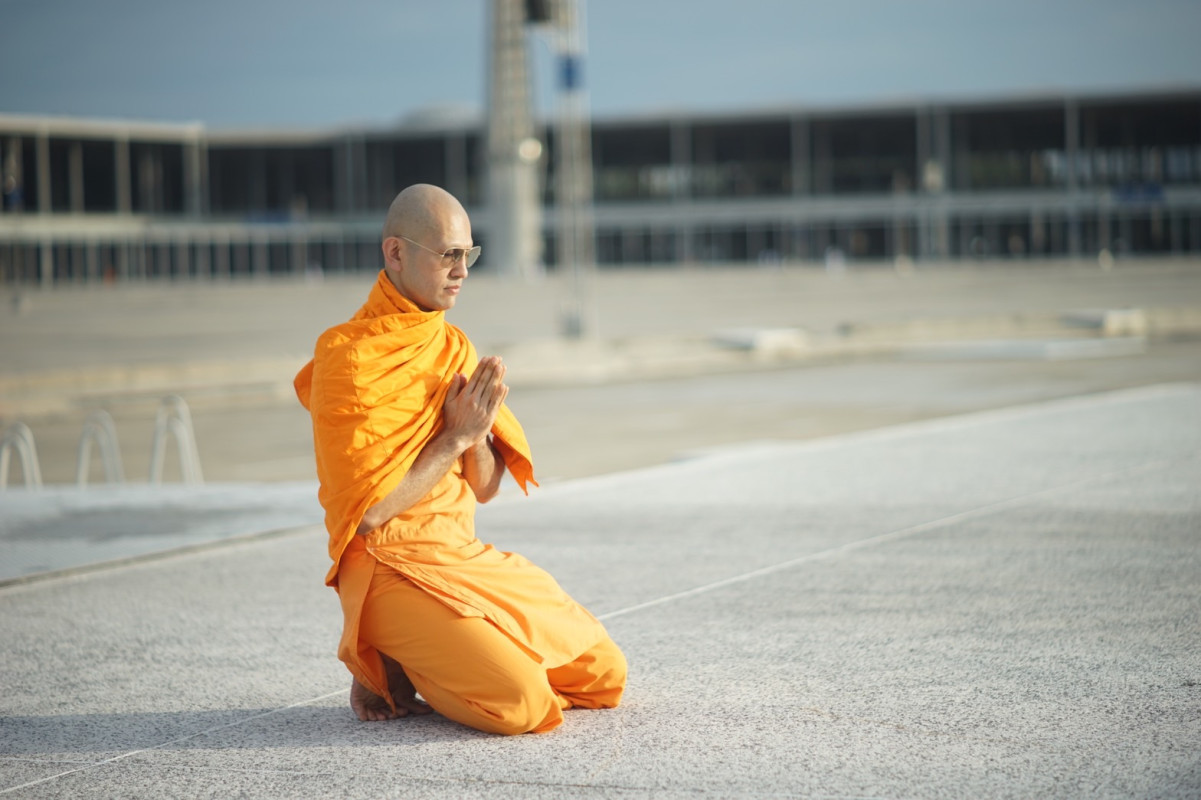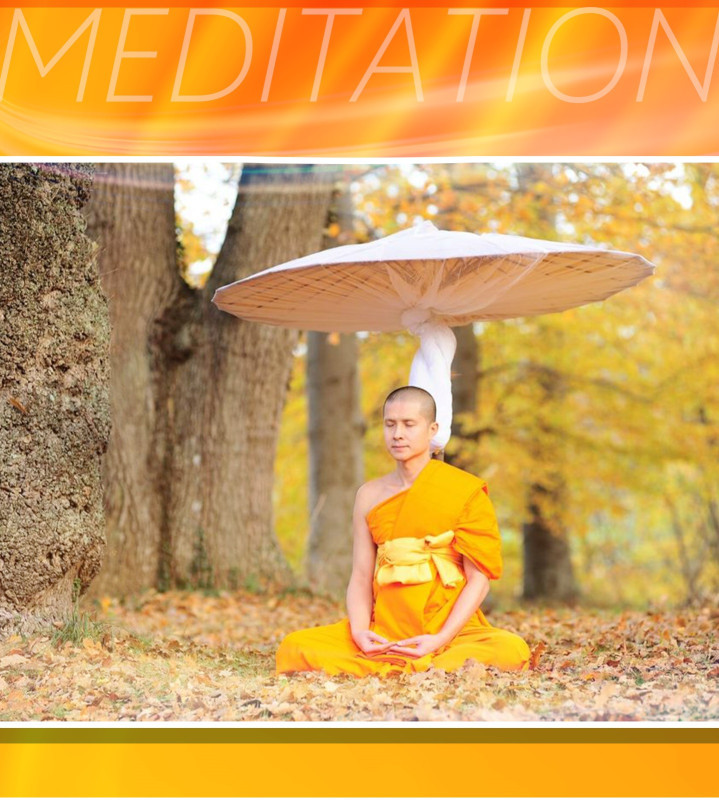Sitting Meditation with Basic Mindfulness Training
Dhamma Practice Cente | Dhamma Center | Dhamma Retreat in Bangkok | Dhamma Practice Attire
Meditation is a state of calm, ease, and profound inner happiness—a pure experience that every human being can cultivate from within. It is a practice encouraged in Buddhism as a foundation for living a peaceful daily life—free from heedlessness, rooted in mindfulness, clear comprehension, and wisdom.This path is not beyond anyone’s ability.It is simple and accessible to all. One such method was compassionately taught by Phra Mongkolthepmuni (Sodh Candasaro), the revered meditation master of Wat Paknam Bhasicharoen, who guided practitioners to discover inner peace through gentle and systematic practice.

Sitting Meditation
Basic Sitting Meditation
1.Paying Respect to the Triple Gem Begin by respectfully bowing to the Triple Gem—the Buddha, the Dhamma, and the Sangha.This act helps to soften the heart and prepare the mind with humility and reverence.Then, take the Five Precepts (or Eight Precepts, as appropriate),as a way of reaffirming your commitment to moral discipline and inner purity.This serves as the foundation for a steady and sincere practice.
2.Kneel or Sit Comfortably with a Reflective Heart Gently kneel or sit in a comfortable, respectful posture—such as sitting with legs folded to the side.Bring to mind the wholesome deeds you have done today, in the past,and the good intentions you have set for the future.Let the heart dwell on this goodness with quiet joy and appreciation.Contemplate until it feels as though your entire body is composed of the very elements of virtue and merit—pure, luminous, and filled with the essence of goodness.
3.Sit Cross-Legged with Gentle Awareness Sit in a cross-legged position.Place your right foot over the left,your right hand resting on your left hand,with the tip of the right index finger touching the left thumb—gently forming a circle.Find a posture that is balanced and natural—not too tense, not too relaxed.Avoid slouching or curving the back.Let your spine be upright, but not rigid.Close your eyes gently, as if you were about to take a restful nap—without squeezing the eyelids or furrowing the brow.Then, set a clear intention in your heart.Let both body and mind become ready—calm, relaxed, and fully prepared to entera state of profound stillness and peace.
4.Gently Visualize a Clear, Luminous Sphere (Meditation Object)Now, softly visualize a clear, radiant sphere—about the size of a pupil of the eye.It should be pure, flawless, and crystal clear—cool and bright, like the twinkling of a star.This clear, spherical image is known as the meditation object (parikamma-nimitta).Visualize it with ease—as if this luminous sphere is resting still and silentlyat the seventh base, the center of the body,two finger-widths above the navel, deep inside.Allow the mind to rest gently on this image,while softly repeating the mantra:“Samma Arahang… Samma Arahang…”This is a form of Buddhānussati—recollection of the Buddha.Alternatively, you may gradually guide the luminous sphereto descend inward through the seven bases,starting from the first base (the nostrils)and moving inward, one step at a time,until it reaches the center of the body.Do this gently—with ease, patience, and a cool, quiet heart—letting both the image and the mantra move in harmony.

On Maintaining the Inner Sphere and Entering Deeper StillnessOnce the luminous inner sphere appears at the center of the body,let your mind rest gently upon it—as if the image has merged with the feeling of calmness itself.If the image fades or disappears,do not feel disappointed or try to chase it.Simply return to a gentle and relaxed awareness,and softly recreate the sphere without forcing—as if a new image replaces the old one.If the image appears outside the center of the body,you may gently guide it inward—gradually, patiently—until it comes to rest, still and steady,at the very center of the body.
Once the sphere is stable at the center,place your attention at the very center point of that image.
It may feel as though a tiny star—a smaller, subtler point of light—is resting perfectly within the middle of the original sphere.Keep your attention gently focused on that tiny center.As you continue in this way, the mind will naturally become still in perfect balance.This is called falling to the center (tok-jhoon in Thai).When this occurs, a new, brighter sphere will arise in its place.
This is known as the Dhamma Sphere, or the Sphere of the Initial Path (Paṭhamamagga).It is the first gateway on the path to deeper realization—the beginning of the way toward Nibbāna.Practice in All PosturesThis recollection and visualization of the inner spherecan be practiced in all postures and situations—whether sitting, standing, walking, lying down,
or even while engaging in daily activities.The true center is always within.And the way inward is always open, wherever you may be.
Guidelines for Sitting Meditation
The most important guideline is to practice consistently and regularly.Make meditation part of your daily rhythm—practice gently, without pressure.There is no need to rush or force the mind.Whatever you can do, let it be enough—be content with each step.This prevents craving or striving from disturbing the mind’s natural balance and neutrality.When your practice matures and the Sphere of the Initial Path (Paṭhamamagga) arises—brighter than brightness, more beautiful than anything you've known—resting firmly at the center of the body,you should frequently recall and gently dwell upon it.By doing so, the fruits of meditation will gradually transform your life.
It will guide you along a path of true happiness, success, and mindfulness,and protect you from heedlessness.Your meditation will naturally grow more refined, subtle, and profound—unfolding step by step, from clarity to clarity,deeper into the stillness of the awakened heart.
Basic Techniques for Sitting Meditation
1. Gently Close the Eyes – Let the Eyelids Rest About 90%
Close your eyes lightly—not tightly shut, but softly,as if you are about to fall asleep.Let the eyelids close about 90%, just enough for the eyelashes to gently touch.This soft closure helps to relax the facial musclesand prevents tension around the forehead and eyes.Avoid squeezing the eyes or pressing the eyeballs,so that the mind can begin to settle with ease and clarity.
2. Do Not Force the Mind — Just Be Mindful and Gently Rest the Awareness at the Center of the Body
Avoid trying to control or push the mind.Simply maintain mindfulness and place the awareness softly at the center of the body—
two finger-widths above the navel, gently within.Choose one single object of focus, and keep it light and effortless:
A clear, luminous sphere (crystal-like)... gently.
A radiant image of the Buddha... gently.
The natural rhythm of the in-and-out breath... gently.
The rising and falling of the abdomen... gently.
Whichever object you choose, stay with just one,and hold it with soft attention—calm, relaxed, and unwavering.
3. Gently and Continuously Visualize the Meditation Object Sustain the gentle visualization of your chosen meditation object (nimitta)as a skillful means to draw the mind inward—so that it becomes stable and centered within the body.
4. When the Mind Comes to Rest within the Body, the Visualization Naturally Ceases As the mind becomes truly still at the center of the body,the need to visualize the object fades away on its own.The mind remains quietly rested and present, without effort.
5. Be Aware of Inner Changes in Body and Mind with Peaceful Attention Observe any inner shifts—whether physical sensations or subtle feelings—with calmness and equanimity.Let changes unfold naturally, without judgment or interference.
6. Stay Under the Close Guidance of a Kalyāṇa-mitta (Spiritual Friend)Walk this inner path under the close care and guidance
of a wise and compassionate teacher—a kalyāṇa-mitta—who can support your progress and protect you from discouragement or missteps.
Principles of Meditation Practice (Sitting Meditation)
1. Gently Gather the Mind at the Center of the Body Each time you meditate, bring your mind to rest at the center of the body.Try to keep it there for as long as possible—until it becomes a habit,and the mind naturally remains settled inward.
2. Maintain Mindfulness at All Times Keep the mind under the watchful care of mindfulness,
so that you are continuously self-aware.Remain equanimous—neither delighted nor disturbed—in response to forms, sounds, smells, tastes, touches, or mental impressions.This includes praise, flattery, status, fame, or recognition.
3. Practice Meditation Consistently and at Regular Times Commit to your meditation practice with sincerity and discipline.Practice at the same time each day, with regularity and devotion.
4. Train Under the Guidance of a Knowledgeable Teacher Place yourself under the care of a teacherwho truly possesses wisdom and experience in meditation.Let them offer close support, corrections, and guidance along the path.

The Benefits of Sitting Meditation
1.1 Mental Well-being
-
Enhances the quality of the mind—making it bright, pure, calm, serene, clear, light, and peaceful.
-
Improves memory, mindfulness, and wisdom, allowing the mind to be sharp and discerning.
-
Strengthens mental performance, enabling quicker and more accurate thinking,
while inclining the mind to focus only on wholesome, beneficial thoughts
1.2 Personality Development
-
Cultivates a refined and confident personality—energetic, vibrant, and dignified in manner.
-
Encourages emotional stability, calm composure, and healthy self-confidence.
-
Improves interpersonal skills—developing charm, grace, and kindness through inner peace.
One becomes less prone to anger and more compassionate and generous toward others
1.3 Daily Life
-
Relieves stress and tension, enhancing both work and study performance.
-
Strengthens physical health, as the body and mind are deeply connected—
a strong, peaceful mind becomes a natural defense against illness.
1.4 Moral and Ethical Conduct
-
Develops right view (sammā-diṭṭhi), deep respect for the law of karma,
and the strength to protect oneself from harmful behaviors. -
Leads to wholesome conduct in both speech and action,
as a pure mind naturally expresses itself through virtuous behavior. -
Fosters contentment, simplicity, patience, and a love of peaceful living.
-
Inspires generosity, humility, and reverence—placing collective well-being above selfish interests.
2. Benefits to the Family
2.1 Brings Peace and Harmony to the Family Meditation helps foster peace and harmony within the family.When each member sees the value of moral conduct and inner cultivation,they naturally uphold ethical discipline (sīla) and live by the principles of Dhamma.Children show respect toward their elders,while elders respond with loving-kindness and compassion.This creates a home filled with unity, mutual respect, and heartfelt connection—a family that moves as one in harmony.
2.2 Promotes Progress and Strengthens the Family Foundation When every family member fulfills their responsibilities diligently,guided by mindfulness and inner stability,the household becomes a foundation for lasting progress and success.Even when challenges or conflicts arise,the family faces them together—calmly, wisely, and with mutual support—ensuring that obstacles are overcome with unity and strength.
3. Benefits to Society and the Nation
3.1 Cultivates a Peaceful Society Free from Crime and Social Disorder Meditation fosters inner strength and moral integrity.
Social problems—such as violence, crime, corruption, and injustice—often arise from individuals who lack ethical values,whose minds are weak and easily swayed by temptation and unwholesome desires.When people practice meditation, their minds become firm, clear, and grounded in virtue.If each member of society trains the mind to be steadfast and composed,such harmful behaviors will diminish, and society will grow increasingly peaceful and harmonious.
3.2 Promotes Discipline and Public Responsibility Those who regularly cultivate a peaceful mind through meditation
naturally develop a love for order, cleanliness, and respect for the law.Such individuals are less likely to litter, break rules, or act selfishly.They will cross the street at proper crossings, care for public spaces, and act with civic mindfulness.This results in a cleaner, more livable environment,and helps reduce the burden on public resources—saving the nation time, budget, and human effort otherwise spent on fixing problems caused by disorder.
3.3 Encourages Social Progress and National Unity When individuals have good mental health, love progress, and work efficiently,
society as a whole thrives.Meditation nurtures people who are willing to sacrifice personal comfortfor the greater good, and who actively cooperate in community efforts.Even when ill-intentioned forces attempt to divide the society,they will not succeed—because citizens with calm, reasonable, and peaceful mindsstand firm in unity, driven by a deep love for peace and harmony.
4. Benefits to Religion (The Buddhist Faith)
4.1 Deepens True Understanding and Appreciation of Buddhism Through meditation, one gains correct understanding of the Buddha’s teachings,and comes to personally realize the true value of Buddhism.Meditation is no longer seen as abstract or mystical—but as the only direct path to end suffering and attain Nibbāna.Such realization arises through personal experience, not blind belief.
4.2 Strengthens Unshakable Faith in the Triple Gem As one continues to meditate, faith in the Triple Gem—the Buddha, the Dhamma, and the Sangha—becomes deeply rooted.Such practitioners are ready to protect and defend the true Dhamma,and become powerful voices for spreading correct practiceto benefit countless others with compassion and clarity.
4.3 Sustains and Prolongs the Lifespan of Buddhism The lifespan of Buddhism is preserved and strengthened so long as sincere practitioners continue to cultivate virtue,practice meditation, and follow the Noble Path.Wherever the teachings are practiced,there the light of the Buddha continues to shine.
4.4 Inspires Others to Uphold and Support the Religion When a person has personally experienced the benefits of Dhamma practice,they are naturally inclined to share it with others—encouraging generosity (dāna), moral discipline (sīla), and meditation (bhāvanā).As more people in society embrace these practices sincerely,true peace and harmony will arise, both in the individual and in the world.

Sitting Meditation
 English
English
 ภาษาไทย
ภาษาไทย





